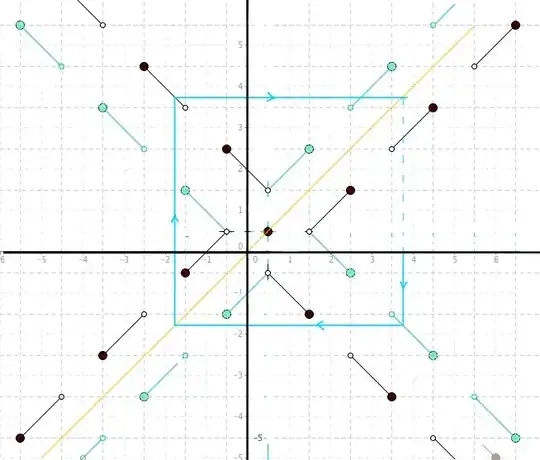As requested within the comment section I will provide the solution as it was derived by a teacher of mine. He struggled for himself and went back and forth several times until he finally got the solution.
First of all we tried to figure out whether the function is invertible or not hence the property $f(f^{-1}(x))=x$ will be quite useful here. By making the assumption $x_1\ne x_2$ and $f(x_1)=f(x_2)$ - in other words the function is not invertible - we get
$$1-f(x_1)=1-f(x_2)\Leftrightarrow f(1-f(x_1))=f(1-f(x_2))$$
and by the functinal equation we obtain $x_1=x_2$ which is a contradiction thus the function is invertible.
Now we applied $f^{-1}$ to the functional equation and so we get
$$f^{-1}(x)=1-f(x)\Leftrightarrow \frac{f(x)+f^{-1}(x)}2=\frac12$$
which states that the arithmetic mean of the function and its inverse equals $1/2$ for all $x$. From hereon my teacher reasoned that this implies the function $f$ is symmetric to the line $y=1/2$. Hence $f$ is defined for all $x$ we can reason that there are points of the graph of $f$ within the I. quadrant and the IV. quadrant as well. Now assume a point $P$ on the graph of $f$ within the I. quadrant (below the line $y=1/2$ otherwise you have to work within the IV. quadrant). Reflect the point on the line $y=1/2$ and $P'$ will lie on $f^{-1}$. Mirroring again this time on $y=x$ leads to the point $P''$ which again lies on $f$. Therefore a rotation of nighty degree around the point $S(1/2,1/2)$reflects the graph of $f$ on itself. By doing this procedure again we will end up on the graph of $f$ aswell. Therefore $f$ is also symmetric towards the point $S$.
Thus consider the points $x_1,x_2$ which are symmetric towards $1/2$ ($1/2(x_1+x_2)=1/2$) which implies
$$\frac12-f(x_2)=-\frac12+f(x_2)\Leftrightarrow f(x_1)+f(x_2)=1 \Leftrightarrow f(x)+f(1-x)=x$$
Additonally $S$ itself is part of $f$. Hence
$$f\left(\frac12\right)=f^{-1}\left(\frac12\right)\Leftrightarrow f\left(\frac12\right)=1-f\left(\frac12\right)\Leftrightarrow f\left(\frac12\right)=\frac12$$
Form hereon the main question remains: are there any functions which satisfy this functional equation; the answer is yes. My teacher constructed a quite weird one but howsoever I will just go on.
Starting with the two cases
$$
f(x)=\begin{cases}\frac12x+\frac34&,\text{for }\frac12<x\le1\\-2x+\frac52&,\text{for }1<x\le\frac54\end{cases}
$$
which satisfy the condition since
$$f_1(1-f_2(x))=\frac12\left(1-\left(-2x+\frac52\right)\right)+\frac34=x$$
where $f_1(x)$ denotes the first branch of the function $f$ and $f_2$ respectively the second one. The crucial point is that adding $1$ to the negative of the one branch automatically results in the other branch. By continuing these relations he obtained
$$
y_n=\begin{cases}\frac12x+\frac34&,\text{for }\frac32-\frac1{4^n}<x\le\frac32-\frac1{2\cdot4^n}\\-2x+\frac52&,\text{for }\frac32-\frac1{2\cdot4^n}<x\le\frac32-\frac1{4^{n+1}}\end{cases}
$$
wiht $n\in\mathbb{N}$. I am not quite sure about this function but it should also provide the solution function on the left side of $S$ by plugging in values of $n\in\mathbb{Z}$. So far so good. I will upload the original notes somewhere so that you can look at them for yourself and understand what I maybe missed right now. Refering to your pseudonym and since you are asking for the solution to a German olympiad question I guess you are capable of reading german.
Here the promised original notes side $1$ and side $2$.
